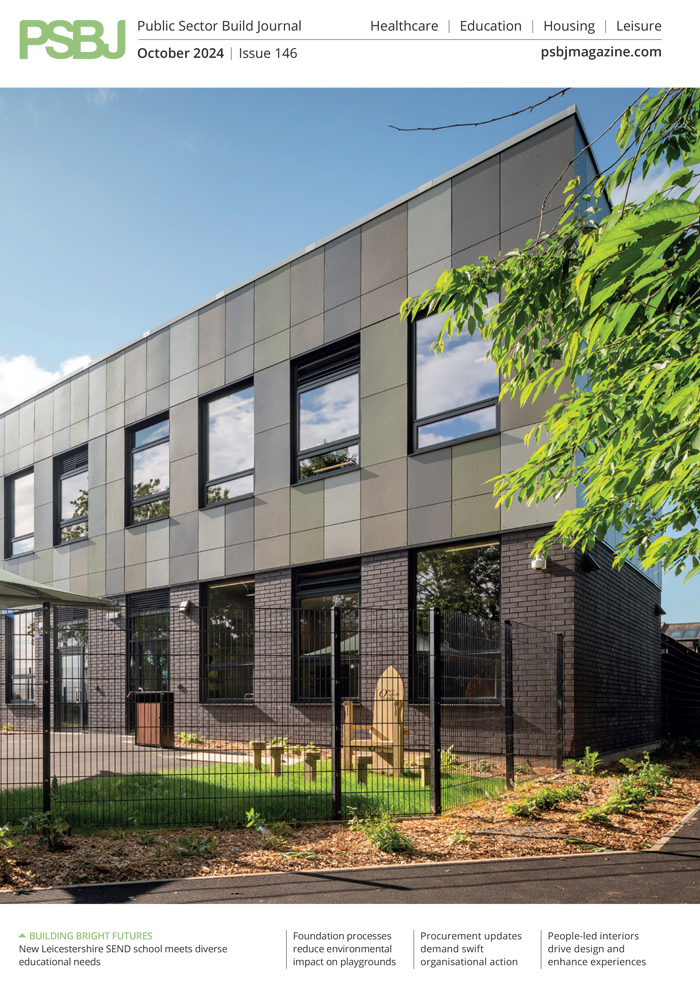Schoolrooms have always been considered sanctuaries of knowledge and growth, providing the setting for teachers to impart knowledge and students to absorb new information. However, the effectiveness of this process often hinges on an overlooked factor – the acoustic environment.
Zentia
The quality of sound within a classroom can significantly impact the learning experience of both students and educators. Inadequate acoustics can lead to a noisy classroom, negatively affecting student’s attitudes, behaviours and retention rates. Additionally, it can even take a toll on the teacher’s health. This pressing issue has prompted the Government to provide guidance in the form of Building Bulletin 93 (BB93) concerning the acoustic design of schools. In light of this, Zentia brings to the forefront the pivotal role of acoustic treatment in classrooms and offers practical solutions, including a range of acoustic ceiling systems.
The sound of success
In a classroom where the teacher’s voice is drowned out by a range of outside noises, such as footsteps, whispers and distant chatter, it becomes challenging for students to focus on lessons. Even when a classroom is quiet, a teacher may have to talk louder to ensure their voices travel to the back of the classroom if there is an imbalance in acoustics. The quality of the sound environment plays a pivotal role in the educational journey, affecting both students and educators alike.
Numerous studies have illuminated the link between classroom acoustics and student engagement. When students struggle to hear teachers due to excessive background noise, their ability to concentrate diminishes, leading to a lack of participation, enthusiasm and an overall negative attitude towards learning. Sadly, not being able to hear and, therefore, retain information in a classroom can also lead to a decline in academic performance and failure to grasp fundamental concepts.
The impact also extends beyond engagement. Studies have also shown that students in noisy classrooms are more likely to display disruptive behaviour, and the frustration of not being able to hear clearly can lead to restlessness, bad behaviour and disciplinary issues.
It is not just students who bear the brunt of inadequate classroom acoustics; teachers can also pay a price. As noise levels increase, teachers may experience heightened stress levels. The constant effort to make oneself heard the most can lead to vocal strain, fatigue and frustration. These stressors can manifest in physiological responses, such as an increased heart rate, which, if chronic, can contribute to more severe health problems like hypertension and heart disease.
Government guidance
Recognising the importance of acoustic design in educational settings, the UK Government has provided invaluable guidance through Building Bulletin 93 (BB93). This comprehensive document outlines the acoustic standards and recommendations for the design of new and refurbished school buildings.
BB93 sets out specific criteria for various spaces within educational facilities, including classrooms, halls and music rooms. It prescribes maximum ambient noise levels and acoustic performance standards that must be met to create a conducive learning environment. The guidance also covers the importance of sound insulation between spaces to prevent unwanted noise transfer, ensuring that classrooms remain a comfortable environment for learning.
Zentia: Crafting sound environments for learning
In the move to fostering optimal learning environments, Zentia stands as a company with expertise and experience in acoustic solutions. Creating a sound environment is a multifaceted task that requires a holistic approach. With a commitment to enhancing the acoustic quality of classrooms, Zentia offers practical solutions that align with the principles outlined in BB93.
A key component of classroom acoustics is acoustic ceiling systems, which play a pivotal role in controlling sound within a space. Acoustic ceiling tiles are specifically designed with sound-absorbing materials that work by reducing the echo and reverberation in a room. Ceiling tiles that also include sound-attenuating properties help to reduce noise transfer from one space to another by blocking unwanted noise.
Zentia offers a diverse range of acoustic ceiling solutions that cater to the unique needs of education settings including large, open spaces. Sonify by Zentia is the latest range of systems, designed to absorb and attenuate sound, reducing ambient noise levels and enhancing speech intelligibility. With a variety of designs and finishes to choose from, Zentia’s acoustic ceiling systems not only serve a functional purpose but also contribute to the aesthetic appeal of large areas, such as canteens and receptions.
In the journey a student makes throughout their educational milestones, the importance of acoustic design often remains an unsung hero. Yet, the quality of sound within a classroom can make or break the learning experience. It shapes students’ engagement, behaviour and retention, while also impacting the wellbeing of educators.
In the pursuit of academic excellence, Zentia offers practical, innovative and reliable solutions for specifiers. With a range of acoustic ceiling systems and customised solutions, Zentia empowers educational institutions to create sound environments that foster engagement, encourage learning and prioritise the wellbeing of students and
teachers alike. Through its commitment to sustainability and expertise in acoustic solutions, Zentia stands apart in the journey to create classrooms where knowledge flourishes in acoustically-sound environments.















